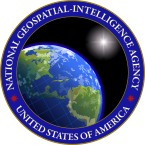
Back الوكالة الوطنية للاستخبارات الجغرافية المكانية Arabic Agència Nacional d'Intel·ligència-Geoespacial Catalan National Geospatial-Intelligence Agency German Agencia Nacional de Inteligencia Geoespacial Spanish Riiklik Georuumiluure Agentuur Estonian آژانس ملی اطلاعات مکانی Persian NGA Finnish National Geospatial-Intelligence Agency French הסוכנות הלאומית למודיעין חזותי וגאוגרפי HE National Geospatial-Intelligence Agency Hungarian
 Seal of the NGA | |
 Flag of the NGA | |
 NGA Campus East, headquarters of the agency | |
| Agency overview | |
|---|---|
| Formed | October 1, 1996 (as the National Imagery and Mapping Agency) |
| Preceding agency |
|
| Headquarters | Fort Belvoir, Virginia, U.S.[1] 38°45′12″N 77°11′49″W / 38.7532°N 77.1969°W |
| Motto | "Know the Earth, Show the Way... from Seabed to Space" |
| Employees | About 14,500[2] |
| Annual budget | Classified (at least $4.9 billion, as of 2013)[3] |
| Agency executives |
|
| Parent department | Department of Defense |
| Website | nga.mil |
| Footnotes | |
| [4] | |
| United States Armed Forces |
|---|
 |
| Executive departments |
| Staff |
| Military departments |
| Military services |
| Command structure |
The National Geospatial-Intelligence Agency (NGA) is a combat support agency within the United States Department of Defense whose primary mission is collecting, analyzing, and distributing geospatial intelligence (GEOINT) in support of national security. Initially known as the National Imagery and Mapping Agency (NIMA) from 1996 to 2003, it is a member of the United States Intelligence Community.[7]
NGA headquarters, also known as NGA Campus East or NCE, is located at Fort Belvoir North Area in Springfield, Virginia. The agency also operates major facilities in the St. Louis, Missouri area (referred to as NGA Campus West or NCW), as well as support and liaison offices worldwide. The NGA headquarters, at 2,300,000 square feet (210,000 m2), is the third-largest government building in the Washington metropolitan area after The Pentagon and the Ronald Reagan Building.[8]
In addition to using GEOINT for U.S. military and intelligence efforts, NGA provides assistance during natural and artificial disasters, aids in security planning for major events such as the Olympic Games,[9] disseminates maritime safety information,[10] and gathers data on climate change.[11]
The eighth and current director of the agency is Vice Admiral Frank D. Whitworth III.[5]
- ^ "NGA Campus East Fact Sheet" (PDF). Archived from the original (PDF) on February 21, 2014.
- ^ "About NGA". National Geospatial-Intelligence Agency. Retrieved May 23, 2021.
- ^ Gellman, Barton; Greg Miller (August 29, 2013). "U.S. spy network's successes, failures and objectives detailed in 'black budget' summary". The Washington Post. Retrieved August 29, 2013.
- ^ "GSP - GSP". www.esa.int.
- ^ a b "United States Navy Flag Officers (Public), June 2022" (PDF). MyNavyHR. Archived from the original (PDF) on June 1, 2022. Retrieved June 2, 2022.
- ^ "About NGA". National Geospatial-Intelligence Agency. August 5, 2021. Archived from the original on August 5, 2021.
- ^ "10 U.S. Code § 441 - Establishment". LII / Legal Information Institute.
- ^ Serbu, Jared (September 27, 2011). "Geospatial intelligence HQ is now DC's 3rd largest federal office building". Federal News Radio. Retrieved March 19, 2016.
- ^ "About NGA". Archived from the original on October 6, 2014.
- ^ "Maritime Safety Information". msi.nga.mil. Retrieved October 23, 2021.
- ^ Perez, Lisbeth (June 3, 2021). "NGA Crunching Climate Change Data for National Security Decision-Making". MeriTalk. Retrieved June 30, 2021.